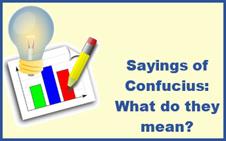ANCIENT CHINA—PART 2
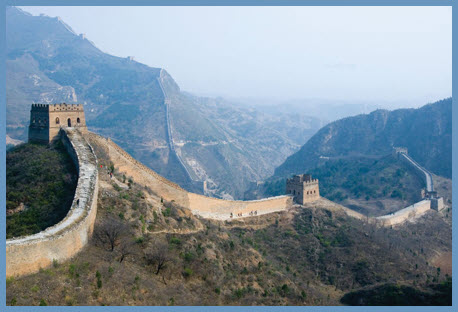
A Section of the Great Wall of China
Unit
Overview
After
the collapse of the Shang Dynasty, the Zhao claimed to have been given by the
gods the right to rule China. This began
a cycle of leadership that would shape Chinese civilization and culture in
ancient and modern times. The
discoveries, accomplishments and failures that took place during the Zhao, Qin
and Han Dynasties continue to impact China and the Eastern Hemisphere today. Let’s see how it all happened. A word of caution—not all scholars and
historians agree on how to spell Chinese names and titles in English. For this reason, some resources, such as
videos and articles, may use different spellings for some of the names found in
this unit.
The
Mandate of Heaven
In
ancient China, a person’s first loyalty was to their family. They viewed their kings as the leaders of the
Chinese people, just as their grandfathers were the leaders of their
families. They believed that the
authority to lead came from heaven and was a gift from the gods. If a king ruled wisely and fairly, he had
their support. This idea of divine
approval was called the Mandate of
Heaven. When a king behaved unjustly
or foolishly, the mandate was taken away, and his dynasty lost its power. Floods, crop failures, earthquakes, peasant
uprisings and other catastrophic events were signs that the gods were about to
pass the Mandate of Heaven to another noble family. The Chinese people were then justified in
rebelling and overthrowing the old dynasty.
In this way, the fall of the old dynasty gave rise to a new one. Historians call this process the dynastic cycle. For 1,900 years, four dynasties—the Shang,
the Zhou, the Qin and the Han—ruled ancient China as one followed the
other.
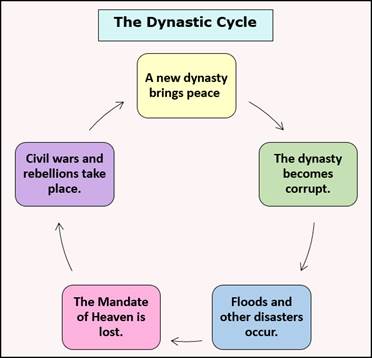
A New
Dynasty Replaces the Shang
While
the royal families of the Shang Dynasty enjoyed a luxurious lifestyle, most
people under their rule remained poor and were treated badly. As a result, they no longer supported their
rulers. In 1045 BCE, Wu Wang led a rebellion and defeated
the Shang. He established a new line of
rulers called the Zhou Dynasty. Like the Shang, Wu Wang divided the kingdom
into smaller territories, but he did not put members of his family in charge in
them. Instead, Wu Wang rewarded loyal
followers by giving them authority over sections of land. In return, these nobles were expected to
defend the king and to fight on his side if asked. These became hereditary positions. In
other words, when the local noble died, his son or another family member took
his place.
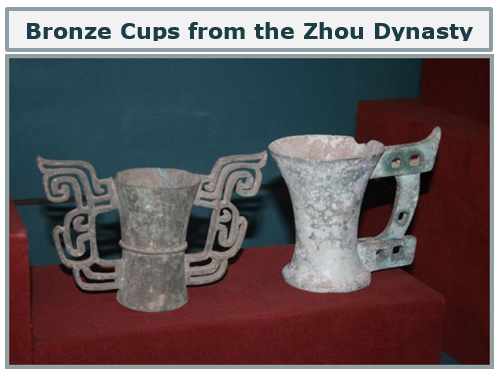
Image Courtesy of Gary Lee Todd
Economic
and Technological Advancements
Under
the leadership of the Zhou Dynasty, China’s economy grew, and its knowledge of
technology advanced. By 559 BCE, the
Chinese were working with iron
instead of bronze. This change resulted
in stronger weapons and sturdier tools.
Iron plows and the invention of the wheel barrow enabled farmers to grow
more food. New crops, such as soybeans,
also increased the food supply. Some
local lords engineered irrigation projects that made farming even more
productive.
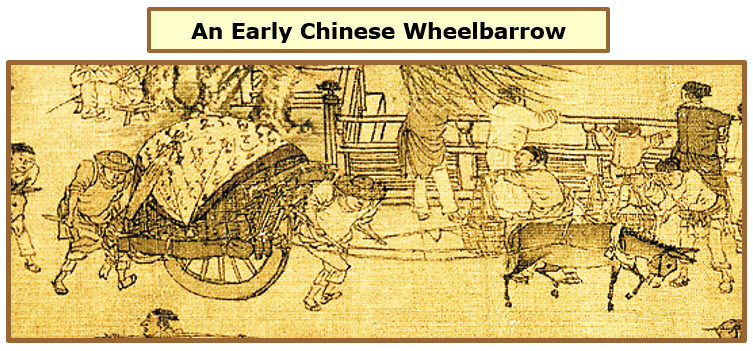
The
food surplus opened up more opportunities for trade. To make exchanges easier, the Chinese made
copper coins and began to use money for the first time. Increased trade inspired some lords to build
roads and canals within their territories.
As the economy grew, so did the population. By 260 BCE, about 50 million people lived in
China. Farmers pushed into new
lands. Soon they were growing crops in the
Chang Jiang Valley in addition to the Huang He Valley.
The
Time of Warring States and the Teachings of Confucius
China
appeared to be a wealthy, prosperous civilization, but the Zhou Dynasty was
facing serious problems. Many of its
local lords had started to ignore the laws of the king. They fought among themselves, and some went
to war on their own with neighboring tribes.
As the lords grew stronger, the Zhou kings grew weaker. China fell into a period of chaos and
confusion. Historians refer to this
period as the Time of Warring States.
Although
most Chinese did not like the violence and lack of order, they were powerless
to stop it. Nonetheless, there were some
scholars and philosophers who had ideas for ending the conflict. One of these was a teacher named Confucius. He lived in early China from 551 to 479 BCE. Confucius believed that order could be
restored if people learned to respect one another. To accomplish this, he taught his students a
code of proper conduct based on five human relationships. These are listed in the table pictured here.
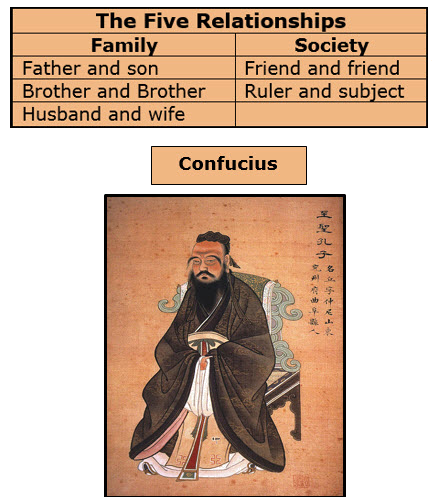
Confucius
thought that good conduct began at home with respect for parents and other
family members. As children grew into
adults, this concept expanded to include respect for friends and government
authorities. At the same time, it was
the ruler’s responsibility to set a good example. If kings led with this in mind, there would
be peace. Although not everyone agreed
with Confucius, some rulers did follow his model for leadership. Confucius
continued to influence Chinese culture long after his death. His students recorded many of his sayings and
stories. They called the collection Analects,
and it is still read today. However,
China’s next dynasty would govern based on a very different philosophy. Click on the graphic here to read some
sayings of Confucius. What do you think
they mean?
The
Qin Dynasty
Weak
kings and constant wars convinced many Chinese that the Zhou had lost its
Mandate of Heaven. It was time for new
leadership. From the Qin province in
western China, Ying Zheng used his
large army to defeat the warring lords and what was left of the Zhou
Dynasty. He had no mercy for anyone who
opposed him. In 221 BCE, he proclaimed
himself Qin Shi Huang, or First
Emperor, at the age of thirty-eight. Qin
Shi Huang established the Qin Dynasty
and claimed the Mandate of Heaven.
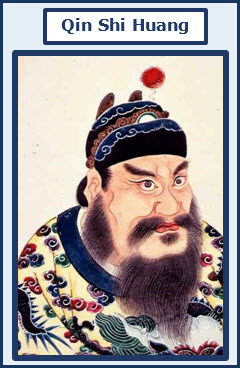
The
restoration of order, however, came at a price.
Qin Shi Huang governed China based on the philosophy known as Legalism. Legalists believed that people should not complain
about the government and should not criticize what it did. Strict laws and harsh punishments were
necessary to control behavior. Under
this system, leaders rewarded the citizens who did their duty and disciplined
those who did not. Many Confucians were
put to death for opposing these policies. Books that did not support the
Legalist point of view were destroyed. Members
of the old royal families were required to live near the emperor to ensure that
they were not plotting against him. Learn
more about the Qin Dynasty by clicking on the graphic pictured here and by watching
the video.
Qin Shi
Huang was determined to complete several public projects. To make it easier to conduct business, he
established a standard system of weights and measures throughout the
kingdom. Additional roads, bridges and
canals were constructed to make it easier for the emperor to control his
lands. He also began to build a long
wall across China’s northern border to keep out invaders. Building walls for protection was not a new
idea, but linking a series of them over a great distance was.
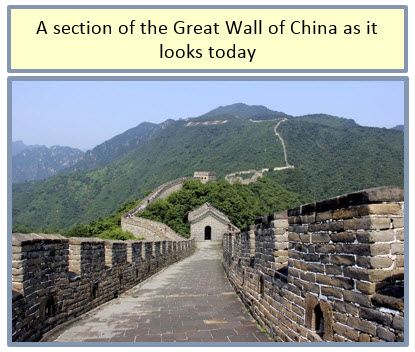
Over
the centuries, other Chinese leaders extended this wall and rebuilt it several
times. Today, it is called the Great Wall of China, and it is one of
the world’s most famous landmarks. Like
the restoration of order, these public projects also came at a price. They were expensive, and the emperor raised
taxes to pay for them. For many Chinese,
this was a major hardship. In the process of construction, thousands of
peasants, who were forced to work on the wall, died from hard labor.
The
Han Dynasty
In 210 BCE, Qin Shi Huang died. He was buried in an elaborate tomb along with thousands of life-size, clay statues of warriors. The Chinese believed that the emperor would need these in the afterlife. Since the clay warriors were first discovered in 1974, archaeologists have worked to recover them. Watch the video to learn more.
Qin
Shi Huang’s son became the next emperor, but it was soon obvious that he was
not prepared to lead. Once again, a
dynasty appeared to have lost the Mandate of Heaven, and civil war followed. Liu Bang and his warriors won the war, and
China was reunited under the Han Dynasty.
Liu Bang gave himself the title Gaozu
and began to put the empire back together.
Although he was a Legalist, Gaozu changed some of the Qin Dynasty’s
strict laws and lowered taxes. He also
added some Confucian scholars to his group of advisers. The Han rulers expanded China’s borders and
continued to work on the Great Wall. Wudi, one of the greatest Han emperors,
opened the Silk Road. For centuries, this group of trade routes
remained the major link between China and the west.
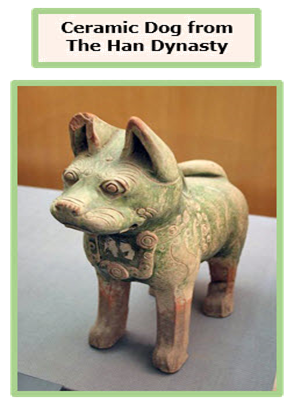
1Image
Courtesy of Gary Lee Todd
Historians
have described the Han Dynasty as one of the golden ages of Chinese
civilization. During this era,
astronomers studied the movement of the planets and the stars. Their observations improved the ability to
keep time. One scientist even invented
an early version of a seismograph, a
device used to detect and to measure earthquakes. Chinese doctors experimented with herbal
remedies and developed anesthetics,
which helped to decrease pain during and after surgeries. Chinese doctors also used acupuncture to relieve pain. This technique consisted of placing needles
under the skin on certain parts of the body.
It is still used as a treatment today.
One of the most important achievements of the Han Dynasty was the
invention of paper. The Chinese combined tree bark and fibers
from cloth rags to create this product.
This discovery made it easier and cheaper to publish books. Paper was also used to keep government
records. These accounts have helped all
of us to learn about life in ancient China.
In spite of their accomplishments, the Han would face rebellions,
peasant uprisings and natural disasters, but their dynasty would rule for China
almost four hundred years.
Time
for a Quick Review
Before
moving on to Unit 18, review the names and terms found in Unit 17. Be sure you can answer the “Can I” questions
with a loud “yes”.
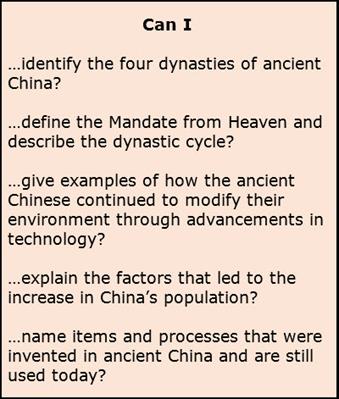

Additional Resources and Activities
Article
with quiz: Philosophers—Confucius
Article
with quiz: The Great Wall of China
